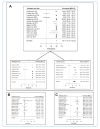Clinical outcomes of intravitreal treatment for ocular toxoplasmosis: systematic review and meta-analysis
- PMID: 37222350
- PMCID: PMC10204153
- DOI: 10.1590/0037-8682-0552-2022
Clinical outcomes of intravitreal treatment for ocular toxoplasmosis: systematic review and meta-analysis
Abstract
Background: Ocular toxoplasmosis is the leading cause of infectious posterior uveitis worldwide, accounting for 30-50% of all cases in immunocompetent patients. Conventional treatment is associated with adverse effects and does not prevent recurrence. Intravitreal drug administration can improve disease outcomes and reduce side effects. Herein, we conducted a systematic review and meta-analysis on the efficacy of intravitreal injections for treating ocular toxoplasmosis.
Methods: The systematic search was conducted using PubMed, SciELO, and Google Scholar with the descriptors "ocular toxoplasmosis" AND "intravitreal". We analyzed studies that met the inclusion criteria, i.e., experimental cases in patients treated intravitreally for ocular toxoplasmosis. Considering the systematic review, we focused on the number of intravitreal injections, the therapeutic drug class, and the presence of preexisting conditions. To assess the efficacy of intravitreal injections, a meta-analysis was performed using visual acuity, side effects, disease recurrence, and inflammatory responses as variables.
Results: Intravitreal injection-induced side effects were rarely observed (0.49% [0.00, 1.51%] ). The use of antiparasitic and anti-inflammatory drugs afforded improved visual acuity (99.81% [98.60, 100.00%]) and marked effectiveness in treating ocular toxoplasmosis.
Conclusions: Intravitreal injections may facilitate the successful treatment of ocular toxoplasmosis. However, clinicians should carefully evaluate the presence of preexisting conditions for ocular toxoplasmosis or previous diseases, as these can impact the decision to administer intravitreal injections.
Conflict of interest statement
Figures



Similar articles
-
Real-World Effectiveness and Real-World Cost-Effectiveness of Intravitreal Aflibercept and Intravitreal Ranibizumab in Neovascular Age-Related Macular Degeneration: Systematic Review and Meta-Analysis of Real-World Studies.Adv Ther. 2020 Jan;37(1):300-315. doi: 10.1007/s12325-019-01147-6. Epub 2019 Nov 14. Adv Ther. 2020. PMID: 31728825 Free PMC article.
-
Intravitreal Injection of Sulfamethoxazole and Trimethoprim Associated with Dexamethasone as an Alternative Therapy for Ocular Toxoplasmosis.Ocul Immunol Inflamm. 2018;26(7):1041-1044. doi: 10.1080/09273948.2017.1307420. Epub 2017 Apr 27. Ocul Immunol Inflamm. 2018. PMID: 28448726
-
Ocular toxoplasmosis: a review of the current diagnostic and therapeutic approaches.Int Ophthalmol. 2022 Jan;42(1):295-321. doi: 10.1007/s10792-021-01994-9. Epub 2021 Aug 9. Int Ophthalmol. 2022. PMID: 34370174 Free PMC article. Review.
-
Intravitreal clindamycin as a therapeutic alternative in severe ocular toxoplasmosis.Arch Soc Esp Oftalmol (Engl Ed). 2019 Dec;94(12):602-604. doi: 10.1016/j.oftal.2019.09.005. Epub 2019 Oct 10. Arch Soc Esp Oftalmol (Engl Ed). 2019. PMID: 31607401 English, Spanish.
-
Intravitreal ranibizumab for the treatment of inflammatory choroidal neovascularization.Retina. 2011 May;31(5):871-9. doi: 10.1097/IAE.0b013e3182003ca8. Retina. 2011. PMID: 21358461
References
-
- Delair E, Latkany P, Noble AG, Rabiah P, McLeod R, Brézin A. Clinical manifestations of ocular toxoplasmosis. Ocul Immunol Inflamm. 2011;19(2):91–102. - PubMed
Publication types
MeSH terms
LinkOut - more resources
Full Text Sources
Medical
Miscellaneous

